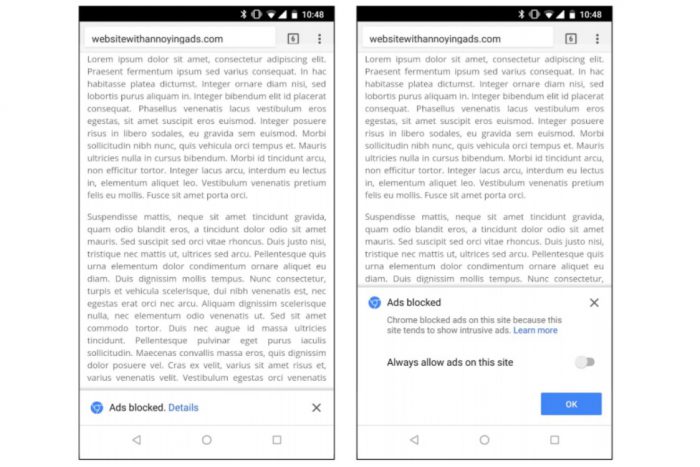Here’s something that will either scare or soothe anyone concerned with the future of digital advertising and the web: Starting tomorrow, Google, the largest advertising company in the world, will take an active role in deciding which ads people will see while using Chrome.
On Thursday, Google plans to release a new Chrome update that will introduce a built-in ad blocker for the browser. The feature, whose existence was first reported last April, will automatically block ads that don’t conform to the Better Ads Standards from Coalition for Better Ads, as Chrome Web Platform product manager Ryan Schoen explained to TechCrunch. On desktop, these include popups, autoplay, sound-on videos, and “prestitial ads with countdown,” a format that, for most, has become synonymous with Forbes.com. The mobile version of Chrome will target those same ad formats, along with flashing animated ads, full-screen scrollover ads, and ads that take up over 30 percent of users’ screens.
What makes this an even bigger deal is that Chrome won’t just block the obtrusive ads. Instead, the browser will block all ads on offending sites, (including, notably, those from Google’s own products, AdSense and DoubleClick). “Chrome blocks ads on this site because this site tends to show intrusive ads,” the browser will tell users (ironically, via a popup).

The move is a big deal, given that Chrome controls around 60 percent of the desktop browser market, according to NetMarketShare. Its mobile browser penetration is also high, almost entirely on Android. In other words, this is a feature that no ad-supported media company can ignore and one whose introduction could have, almost overnight, a material impact on how people experience the web.
Here’s how Chrome vice president Rahul Roy-Chowdhury explained the thinking behind the decision in a blog post on Tuesday:
The web is an ecosystem composed of consumers, content producers, hosting providers, advertisers, web designers, and many others. It’s important that we work to maintain a balance — and if left unchecked, disruptive ads have the potential to derail the entire system. We’ve already seen more and more people express their discontent with annoying ads by installing ad blockers, but blocking all ads can hurt sites or advertisers who aren’t doing anything disruptive. By focusing on filtering out disruptive ad experiences, we can help keep the entire ecosystem of the web healthy, and give people a significantly better user experience than they have today.
The Chromium blog (that’s Chrome’s open-source sibling) has some technical details about how the blocking will work.
As of February 12, 42% of sites which were failing the Better Ads Standards have resolved their issues and are now passing. This is the outcome we are were hoping for — that sites would take steps to fix intrusive ads experiences themselves and benefit all web users. However, if a site continues to maintain non-compliant ad experiences 30 days after being notified of violations, Chrome will begin to block ads on that site.
We’re encouraged by early results showing industry shifts away from intrusive ad experiences, and look forwarding to continued collaboration with the industry toward a future where Chrome’s ad filtering technology will not be needed.
But while Google is positioning itself as a benevolent protector of the web and a defender of its users, the move is still off-putting because it’s not hard to see how easily Google could tweak the Chrome ad blocker’s functionality to benefit its own ads, or disadvantage those of competing ad companies. One important point: The Coalition for Better Ads standard that Chrome uses is built around Google’s own data, as AdAge reported. That certainly complicates the notion that Google is a neutral party in all of this.Will this really be a good move for the web? It’s too early to say.
I would just like to point out again that having the world’s largest digital advertising company decide which ads to show in the world’s most popular browser is a bad idea https://t.co/lgAKGN7tgx
— Mathew Ingram (@mathewi) February 14, 2018